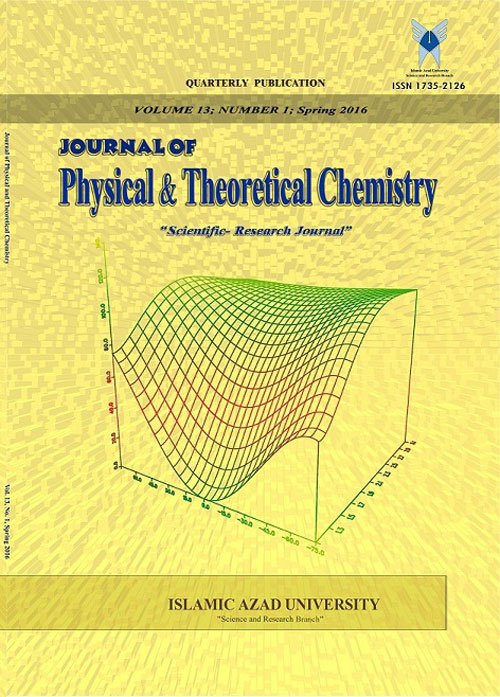فهرست مطالب

Journal of Physical and Theoretical Chemistry
Volume:16 Issue: 1, Spring 2019
- تاریخ انتشار: 1399/04/24
- تعداد عناوین: 6
-
Pages 1-6The thermodynamic functions such as enthalpy, H°, Gibbs free energy, G°, and entropy, S°, of Arginine and Lysine amino acids were theoretically studied at different polar solvents by using ²Gaussian o3², software. First, the structural optimization of isolated Arginine and Lysine were done in the gas phase by applying the Density Functional Theory (B3LYP) level with 3-21G, 6-31G and 6-311G basis sets. Moreover, vibrational frequencies were calculated in gas phase on the optimized geometries at the same level of theory to obtain enthalpy, H°, Gibbs free energy, G°, and entropy, S°. Then, the calculation about the solvent effects on the thermodynamic functions of Arginine and lysine amino acids were performed for the various polar solvents (Water, Methanol and Ethanol) by using self-consistent Reaction-Field (SCRF=PCM) model at B3LYP/6-311G. Thermodynamically analysis shows the relative enthalpy changes, DH°, Gibbs free energy changes, DG°, are negative values but the entropy changes, DS°, are positive values for Arginine and Lysine molecules. Also, the results shows, with increasing dielectric constant of solvents the stability of considered molecules increases.Keywords: Amino acids, Arginine, Lysine, B3LYP-calculations, Thermodynamic functions
-
Pages 7-13toxicity, cancinogenic activity, and mutagenicity. The purpose of this study was evaluation of the removal of Reactive Red 120 (RR-120) dye from aqueous solution by date Palm (Phoenix dactylifera) seed particles. Batch adsorption studies carried out to study various parameters included contact time, initial concentration of Reactive Red 120, pH, and adsorbent dosage. The concentration of dye was measured using a UV-vis Spectrophotometer at the wavelength of 520 nm. Freundlich and Langmuir isotherms were used to analyze the isotherm. it was found that Langmuir isotherm (R2=0.9991 and qm =1.68 mg.g-1) is well fitted with our data. According to Thermodynamic analysis, the process exothermic and natural (ΔHo= -0.006 J.mol-1 and ΔSo= -13.9 J.mol-1K-1). To evaluate the mechanism of adsorption, pseudofirst order and second order kinetic models were used. The adsorption mechanism was found fit the second order (K2= 0.4 mg.g-1.min-1 and R2= 0.999).Keywords: Reactive Red 120, Adsorption, Thermodynamic, Date Cores Particles, Kinetic
-
Pages 15-28
The main objective of this work is to investigate the adsorption of Pyrrole 2-carboxylic acid (PCA) from O, N and C sites on the surface of pristine and Ni doped B12N12 nano cage by using density functional theory (DFT). The results of adsorption energy indicate that the adsorption of PCA on the surface of B12N12 and NiB11N12 is exothermic and favorable in thermodynamic viewpoint. Comparison results reveal that adsorption of PCA from O head on the surface of B12N12 nano cage is more favorable than other sites, and the recovery time of this site is 2.72×1022 s. The change percent of gap energy for adsorption of PCA molecule on the surface of pristine B12N12 nano cage is more than Ni doped, thereby the pristine B12N12 nano cage can be a good selected for making PCA sensor. The changes Gibbs free energies in water phase (∆∆G(sol)) for adsorption of PCA from N and C site of PCA on the surface of B12N12 are negative and spontaneous. The atom in molecule (AIM) and reduced density gradient (RDG) results indicate that the adsorption PCA from N and C sites on the surface of B12N12 is strong covalent type, and for other sites is partially covalent bond.
Keywords: Pyrrole 2-carboxilic acid, B12N12, Ni doped, DFT, NBO -
Pages 29-35
The lubricating oils in each mechanical device are affected by shear forces. Polymers in lubricating oils engine, in particular, undergo many changes because of the influence of the applied forces. Awareness of these changes can help us to design optimal formulations. In this work, shear stability of four commercial was studied. Calculation of various parameters about viscosity in the enhancing were performed and compared. The results of this study can be used for optimizing the usage of polymers in engine oil.
Keywords: Shear stability, polymers Viscosity index, Engine oil -
A deductive kinetic study of diclofenac release from chitosan-based magnetic nanocomposite hydrogelsPages 37-47
A descriptive study of isothermal kinetics of diclofenac release from chitosan-g-acrylic acid (Chit-AA) hydrogel and chitosan-g-(acrylic acid-co-[2-(acryloyloxy)ethyl]trimethylammonium chloride) (Chit-AA-AETM) hydrogel was carried out. Isothermal kinetic curves for diclofenac release from both hydrogels in distilled water at various temperatures of 20-42°C were studied. The fit method of the famous model was used to determine the kinetic models of both the drug release process and the external solvent absorption onto the hydrogel. Based on the fixed dependencies of kinetic parameters (LnA, Ea) on the amount of abandoned diclofenac (α) in the presence of compensatory effect, the function of the new molecular mechanism of a drug transfer process was investigated. According to that mechanism, drug release is considered as an isolation of the drug from the active separation centers of various hydrogels with different energies.
Keywords: drug delivery systems, isothermal kinetics, hydrogel, Drug release -
Pages 49-55Drug delivery by nanomaterials is an active emergent research area and CNTs draws considerable potential application owing to its unique quasi one-dimensional structure and electronic properties. Single walled carbon nanotubes and carbon fullerenes can be used in drug delivery due to their mechanical and chemical stability. The past few years, increasing attention by several reputed groups has been devoted on functionalization of carbon nanotube s ( CNT s).In this paper, we reported the effects of covalently binding isoniazid, an metformin molecule to functionalized carbon nanotube. In this work, binding energies, energies of solvation, computational-chemistry molecule descriptors with use density function theory(DFT) method and 6-31G*,6-31G** basis set were calculated. The results show to covalently bind isoniazid to functionalized carbon nanotubes suitable for carrier’s metformin molecule. We have performed DFT calculations for f-SWCNTs in order to assess their roles as nanovectors for drug delivery of metformin.Keywords: Functionalized CNT, Metformin, drug delivery

